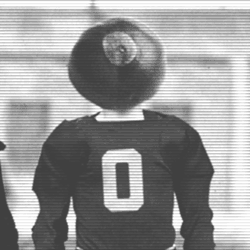It's not for dummies, but this will be a decent starter kit for any lacrosse novice. I will do my best to keep it fairly easy to understand for all who read, even if you have never watched a game. It's okay to be new, just try to stick around and seize the opportunity to know more! Everyone has been there.
Lacrosse is played on a field 110 yards long and 60 yards wide. It features three dividing lines across the width of the field, which denote a team's defensive zone, the midfield line, and the team's offensive zone.
The lines denoting offensive and defensive areas are called restraining lines. They each have perpendicular lines that run directly to the endline and show the restraining box. This denotes the area in which the offensive and defensive players must stay during a faceoff until possession of the ball is signaled.
All faceoffs occur directly at midfield, designated by a small "x" on the midline, with three players from each team allowed to participate. Two players fight for control of the ball directly, while the remaining four players stay behind the wing lines that bisect the midline in a perpendicular manner until the whistle blows.
These 4 players may not interfere with the faceoff until the ball is drawn, kicked, or otherwise moved into play. Once the ball has been put into play, only the 6 designated players may attempt to gain control of it outside of the restraining boxes. As soon as one of these players does so, the referee will yell "possession" and signal the shot clock to start.
The object of the game is to put a white rubber ball into the other team's goal more times than an opponent can put that ball in your goal. Goals are worth one point each. Assists are given for the final pass leading to a goal, much like hockey or soccer.
There are 2 goals. Each goal is 6 feet high and 6 feet wide. The goal is placed on a six-foot line showing the goal-line. A goal is scored when the ball crosses the goal-line completely. The goal is located inside a circle that is 18 feet in diameter. This is known as the crease, and only defensive players may enter the crease during the course of play.
The exception is when an offensive player leaves his feet with possession of the ball, in a direction away from the goalmouth, shoots and scores before landing in the crease. The direction requirement is enforced with a second crease that shows where an offensive player may not land after leaving his feet.
The shot clock runs for 80 seconds, and resets whenever the ball is turned over, or hits the goal or goalie for a save. The shot clock does not reset if the ball was not touched by the goalie or goal on the way out of bounds.
When a team gains possession of the ball off the faceoff and the shot clock begins, the team now on offense has 20 seconds to cross the midline if the ball was won in the defensive zone. If the ball was possessed in the offensive zone, the team had 80 seconds to now get a shot on the goal. This is when substitutions happen, and the offense gets set up.
Each team consists of 10 players. There is 1 goalie, who has the widest stick on the field, with the deepest pocket, and is responsible for stopping the ball from going in the goal. The goalie is the primary resident of the crease and goalmouth.
He is given exclusive rights to possession of the ball in the crease, without interference. The goalie is also the only player who can move the ball from the field of play into the crease. Once the goalie gains possession, he has 4 seconds to get the ball out of his stick to a teammate before he must exit the crease.
The goalie has 3 defenders who must always remain on the defensive side of the field. Each of these players has a 6-foot stick that they use to defend their offensive counterpart. The defenders usually are the biggest players on the field, standing well over 6 feet, and are responsible for preventing attackmen from getting shots off.
The rule applies to a number of players, not their sticks. I.e., a long pole can carry the ball into the offensive zone, however another player must stay in the defensive end to maintain that 3 player minimum. Often that player can be seen at midfield with his stick raised high in the air to show the officials that the team in possession is onside.
Each team also has 3 attackmen, who are required to stay in their team's offensive half of the field at all times. These players are required to have a regulation short stick.
Attackmen generally have more lacrosse IQ and stick skills, without overwhelming athleticism you see in middies. Not saying attackmen aren't athletic, just that they tend more towards quick than fast, and don't usually have the wind of middies.
Finally, each team has 3 players called midfielders, middies for short, that can go all over the field without restraint. When on defense, one of these players can have a long-stick, hence the name long-stick middie, or LSM for short. The LSM functions as a fourth pole defender, usually assigned to an opponent's best offensive middie. In a now bygone era, there were two LSMs allowed on the field, for five longpoles total.
That was changed in the 70s, I believe, to make the game a bit more open. The other two defensive middies MUST carry a short stick by rule, making them the marked men of lacrosse. Every offense is looking to take advantage of the short stick middies, hoping to turn matchups into goals. A good SSDM is worth his weight in gold.
Offensively, the three middies tend to be the most athletic players on the team, and will usually have at least one of the primary dodgers for an offense. The better teams will have two, the best have three dodgers.
A dodge, at its most basic, is essentially a drive from the point guard in basketball, except there's much more contact allowed in lacrosse. The object is to use speed, strength, and guile to get an open shot on the goal, or to make the defense rotate and find the open man. Either of these is an acceptable outcome for a dodge.
Dodges are often scripted maneuvers, but the best dodgers can combine multiple dodges into one hybrid. When done right, a dodge is a thing of beauty. When done wrong, it's embarrassing to watch, even more embarrassing when you know you're supposed to be coaching the player better. Don't ask me how I know.
Generally, the lacrosse ball is considered live until it crosses any line marking the boundaries of the field. Once the ball goes out of bounds, possession is awarded to the opposing team, unless the ball was shot out of bounds.
On a shot, the player closest to the ball when it goes out of bounds is awarded the ball. That is why every player reaches out with their stick when a shot misses the cage. The stick doesn't count as part of a player's body, but allows players to stretch themselves to gain an advantage. Aside from shots, any pass of the ball or dropping of the ball out of bounds is automatically a turnover.
A team has 80 seconds to shoot the ball once it gains possession. It doesn't matter if a turnover has occurred, the ball is picked up off the ground, or there is a shot. Each results in 80 seconds to get the ball on cage. The shot clock resets every time a shot hits the goalposts, or is saved by the goalie.
If an offense has the ball in the offensive zone with less than 60 seconds on the shot clock, and it crosses the midline, possession goes to the opposing team. Crossing the midline is allowed multiple times in the first 20 seconds of the shot clock, if the ball is being cleared from the defensive zone to the offensive zone only.
Substitutions are allowed through the substitution box only. Failure to sub through the box is a violation resulting in a turnover of the ball, or a :30 penalty. Don't ask me how I know. Each player must be fully off the field before his replacement may enter. In college lacrosse, teams almost always utilize the midline to substitute when going from offense to defense.
I.e. as the ball is advanced into the zone, a defender will be pulled from the defensive zone and replaced with an offensive middie. The middie will go to the faceoff "x" and wait for a defensive middie to sprint across the midline, then cross the midline into the offensive zone and begin actively playing. This will occur until all offensive personnel are in the zone.
Utilizing this pattern allows teams to get temporary 6 on 5 opportunities, whether the opponent subs through the midline or the box. That's where a lot of goals can be manufactured, meaning the sub game is an underrated means of winning lacrosse games.
Penalties are listed in the rulebook, and are enforced like hockey. There is a time associated with each penalty that prevents a player from re-entering the game, and his team from replacing the penalized player. Times vary from :30 to 3:00, releasable (upon a goal) or non-releasable (full-time no matter how many goals are scored). While an important part of the game, a really good team will only score goals on 40% of their Man-up opportunities.
Since teams only get around 65 to 75 chances per season on the Man Up, you're looking at 26 to 30 goals scored IF you get to that conversion percentage. Most good teams get to around 35%, making it even less. Regardless, penalties can win or lose you a game, and can't be overlooked.
Hopefully that covers the basics of how the game works for new fans. If you have more questions, ask in the comments and I will answer (or one of the others will) as soon as possible.
Go Bucks!

